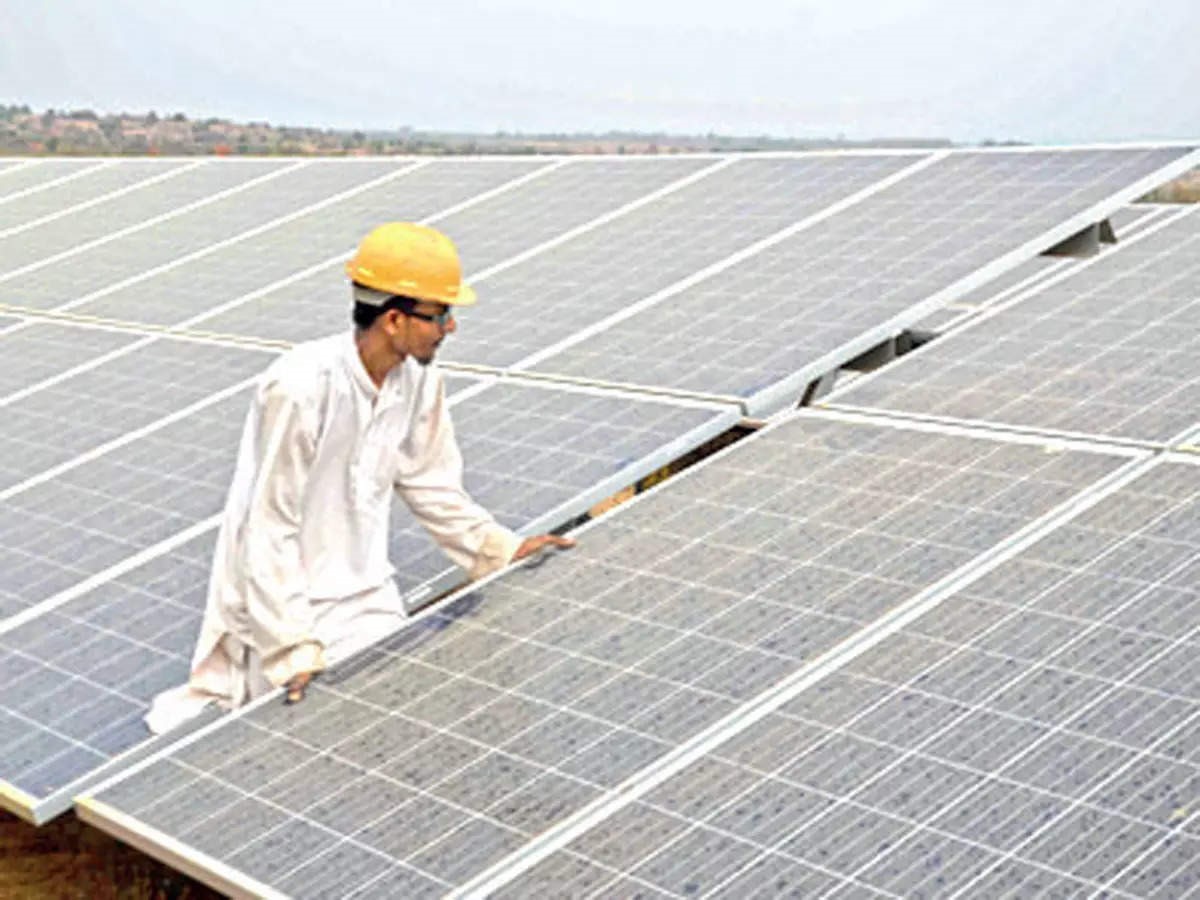Friday, 29th October 2021
India rejects net zero carbon emissions target
News
India has rejected the net zero emissions target ahead of COP26 climate talks.
About the News
- India rejected calls to announce a net zero carbon emissions target and said that it was more important for the world to lay out a pathway to reduce such emissions and avert a dangerous rise in global temperatures.
- India, the world’s third-biggest emitter of greenhouse gases after China and the United States, is under pressure to announce plans to become carbon neutral by mid-century or thereabouts CoP26.
- Representatives of nearly 200 countries will meet in Glasgow, Scotland, from October 31 to November 12 for climate talks to strengthen action to tackle global warming under the 2015 Paris Agreement
- As per United Nations Intergovernmental Panel on Climate Change if the world needs to limit global warming to 1.5°C the global carbon dioxide emissions would need to reach net zero around 2050
About India’s stand on Net Zero Emission target
- As per India, Net zero is not the solution to the climate crisis. Indian opined that “It is how much carbon you are going to put in the atmosphere before reaching net zero that is more important”
- Energy Demand: India’s energy demand is expected to rise sharply over the next decade as the economy continues on its growth trajectory. India is still largely dependent on fossil fuels like coal and oil.
- Commitments by India so far: India has committed to cutting the emissions intensity of its GDP by 33% to 35% by 2030 from 2005 levels, achieving a 24% reduction by 2016.
- Expert Opinion: Some environment experts say that India could consider lowering its emissions intensity by as much as 40 percent dependent on finance and whether it has access to newer technologies.
What is the Net zero emission target?
- About: Net zero emissions refer to achieving an overall balance between greenhouse gas emissions produced and greenhouse gas emissions removed from the atmosphere. The removal is done through natural means or by using the still nascent carbon capture technology.
- Targets by Countries: The United States, Britain and the European Union have set a target date of 2050 to reach net zero, by which point they will only emit an amount of greenhouse gases that can be absorbed by forests, crops, soils and still-embryonic “carbon capture” technology.
- Reasons for the target: The countries opined that by 2050 they will only emit an amount of greenhouse gases that can be absorbed by forests, crops, soils and still-embryonic “carbon capture” technology.
Sources:
Agni-5 Vs China Hypersonic Missile
In News
The Strategic Forces Command has recently test fired Agni-V missile which marks the formal induction of the weapon into the Indian arsenal.
About the News
- Though inducted over three years ago, India’s foremost Agni 5 ballistic missile was tested for the first time by the user agency, the Strategic Forces Command, recently.
- The nuclear-capable missile is India’s contender for the Intercontinental Ballistic Missile (ICBM) with a range of 5,000 km.
- The latest test comes at a time when the relations between India and China are at a nadir, and after reports that China had tested a new hypersonic missile in August.
- With this test, India’s Strategic Forces Command has a force of land-based ballistic missiles which include:
- The Prithvi SRBM (short-range ballistic missile)
- The road-mobile Agni-I MRBM (medium-range ballistic missile)
- The rail mobile Agni-II IRBM (intermediate-range ballistic missile)
- The rail-mobile Agni-III IRBM
- The road-mobile Agni-IV IRBM and
- The road-mobile Agni-V ICBM (intercontinental ballistic missile)
Agni-5 Vs China Hypersonic Missile
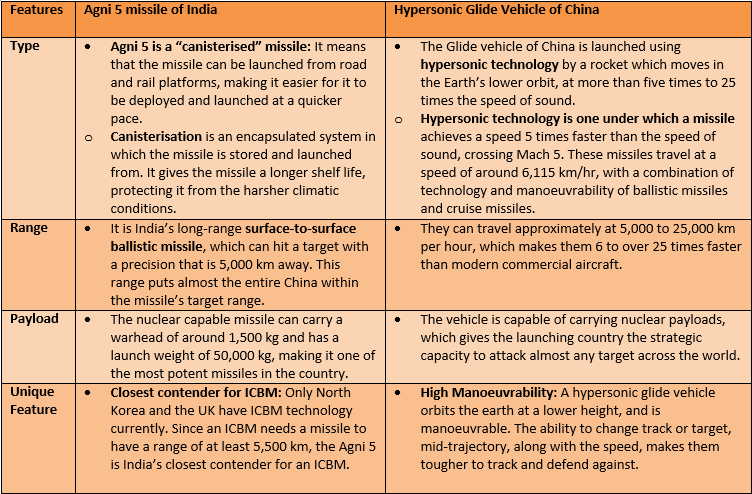
Source:
Mullaperiyar dam: Dispute between Tamil Nadu & Kerala
In News
Recently, the Supreme Court directed that the maximum water level in Mullaperiyar dam should be 139.50 ft until November 10
About the News
- Basis for decision: The Supreme Court order came after a court-appointed supervisory committee had suggested 139.50 ft as the permissible level.
- Background: Tamil Nadu had wanted the level increased to 142 ft as fixed by the Supreme Court in 2014, while Kerala wanted it within 139 ft as per a rule curve fixed until the end of the month.
- What has revived the dispute is the unusual rains in the last couple of weeks, which have led to the water level inching towards its permissible level of 142 ft.
- Centre of Dispute: The dam is at the centre of a decades-old dispute: for Kerala, where it is situated, the dam presents a threat to lakhs living downstream.
- For Tamil Nadu, which controls the dam, the water it provides is the lifeline of people in five districts.
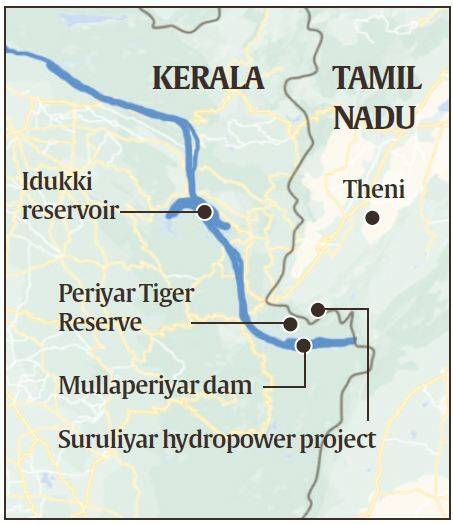
About the Dispute
- The dispute is about the safety concerns around the dam.
- In 2008, a flood routing study by IIT Delhi found the dam was unsafe; in 2009, IIT Roorkee reported the dam was in an earthquake-prone area and would not survive a major quake.
- The dam is located in Kerala and a dam break presents a threat to lakhs living downstream. For Tamil Nadu, which controls the dam, the water it provides is the lifeline of people in five districts.
- After a joint inspection by Kerala and Tamil Nadu in 1964, the water level was reduced from 155 ft to 152 ft.
- In 2006, the Supreme Court allowed Tamil Nadu to raise the water level to 142 ft and to 152 ft after completing strengthening work and if an expert committee examined and recommended it.
- In 2006, Kerala amended the Kerala Irrigation and Water Conservation Act, 2003, bringing Mullaperiyar in the schedule of ‘Endangered Dams’ and restricting its storage at 136 ft.
- In 2010, the Supreme Court formed an empowered committee to look into the dam’s safety.
- In 2014 the Supreme Court allowed Tamil Nadu to fix the water level at 142 ft.
Current Status
- For now, Tamil Nadu agreed to release water through spillway shutters.
- Kerala has been demanding a new dam replacing the existing one.
- Construction of a new dam would need the consent of Tamil Nadu and also give rise to a demand for a new water-sharing treaty; at present, only Tamil Nadu has rights over the dam water.
About Mullaperiyar dam
- The dam is located in the upper reaches of the river Periyar, which flows into Kerala after originating in Tamil Nadu. The reservoir is within the Periyar Tiger Reserve.
- The water diverted from the reservoir is first used for power generation in lower Periyar (by Tamil Nadu) before flowing into the Suruliyar, a tributary of Vaigai river, and then for irrigating nearly 2.08 lakh hectares in Theni and four other districts farther away.
- In 1886, the then Maharaja of Travancore signed the ‘Periyar Lease Deed’ with the British government, to divert the water into arid regions of Tamil Nadu.
Sources:
Rapid Urbanization
In News
Rapid urbanization is visible from the estimation that by 2050 more than two thirds of the world’s population will live in cities, up from about 54 percent today.
About the News
- India is one of the fastest growing economies in the world, and its growth is propelled by its cities. Evidently, Oxford Economics’ Global cities report estimates that 17 of the 20 fastest-growing cities in the world between 2019 and 2035 will be from India.
- Interestingly, India is currently at a unique tipping point in its journey of urban development, with 300 million new urban residents projected by 2030.
What is Rapid Urbanization and why is it on the rise?
- Meaning: Rapid increase in urban population as a proportion of total population results in rapid urbanization.
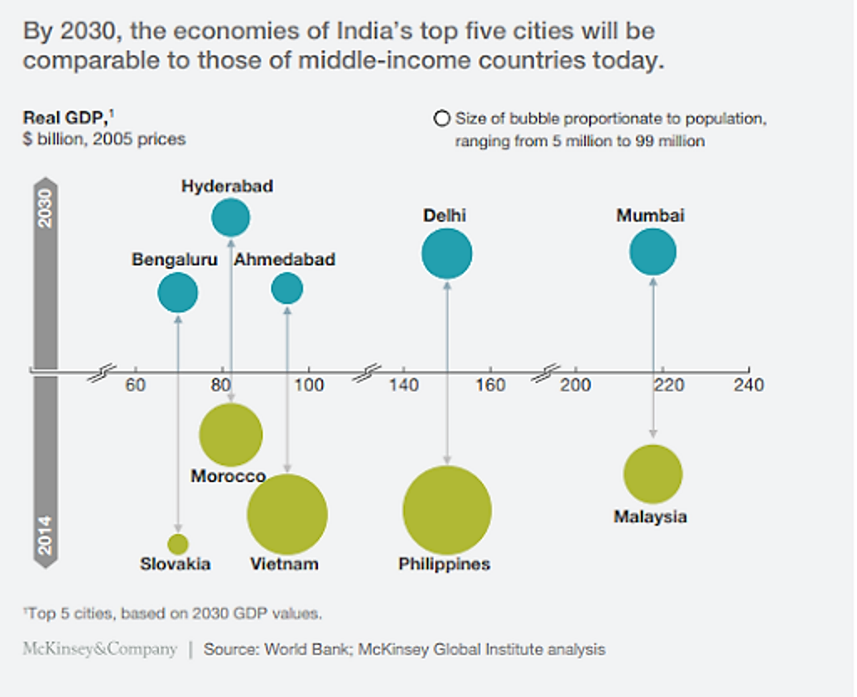
- Indicators of Rapid urbanization: The UN has highlighted that India’s urban population size will nearly double between 2018 and 2050, from 461 to 877 million.
- Factors contributing to its rapid growth: Urbanization is not a side effect of economic growth; it is an integral part of the process. Factor contributing to rapid urbanization are:
- High Economic contribution: While the urban population contributes about 63% to Indian GDP at present, the same is expected to rise to 75%.
- Attracts Talent: Metropolitans are the centres of economic growth and job creation. They enjoy economies of agglomeration that ensures steady growth, which further draws in the talent pool.
- Attracts FDI: Cities contribute about two-thirds of its economic output and are the main recipients of FDI.
- Laboratory for Innovations: Urban areas are the originators of innovation and technology.
- Better Living: The health of city dwellers increasingly benefits from better access to education and healthcare, better living conditions, and targeted public-health interventions
- Promotion of Urbanisation: Globally, there is consensus over the promotion of urbanisation. Most national governments, including India, consider urbanisation as an important component of their development agenda.
While rapid urbanization is a turn towards greater economic growth, it also comes with a set of challenges with regards to liveability.
- Unplanned Agglomerations: Since Indian cities have grown in an unplanned manner. Poor urban infrastructure - such as unreliable power systems, congested roads and poor public transport, inefficient ports and inadequate schools - reduces cities' economic prospects.
- Rising Inequality: Despite high economic growth, India cities are also the centres of high income inequality and poor quality of life. In 2019, New Delhi and Mumbai ranked 118th and 119th respectively, on the Economist Intelligence Unit's Global Liveability Index 2019 that covered 140 cities.
- Lack of Revenue with ULBs: Although there is a broad range of functions for ULBs outlined by the Constitution, the revenue required to deliver on those functions is dependent on the Centre and State.
- Human development challenges: It is estimated that nearly 40 percent of the world’s urban expansion may be in slums, exacerbating economic disparities and unsanitary conditions.
- Fertile ground for Communicable diseases: When urbanization is rapid and unplanned, a combination of high population density, poverty and lack of infrastructure can foster conditions for communicable diseases to flourish.
- Climate Change: Rapid, inadequate and poorly planned expansion of cities can also leave urban populations highly exposed to the effects of climate change.

- Social Instability: While moving to a city offers individuals more opportunities to improve their living conditions, the high cost of living and competition for livelihoods can also trap people in poverty. Rapid urbanization can also quickly lead to urban violence and social unrest.
- Changing Occupational Patterns: The spatial expansion and penetration of urban development in rural hinterlands is leading to reduced farm lands and changing occupational patterns of villagers, seen in a shift to non-agricultural work.
To be able to fully capitalise on the opportunity, policymakers will have to address a few key issues.
- Recognition of Urbanization: As rural settlements are transforming, they begin to display characteristics similar to those witnessed in urban areas. However, state governments are known to be reluctant in converting such villages to towns.
- Leverage data: Data collected through different modes in urban areas can be utilized for informed decision making through charting out customized plans for individual cities.
- Sustainable Growth: To achieve sustainable growth, these cities will have to become more liveable and safe with clean air. An integrated and compact design of transport, infrastructure and land use is at the core of providing a foundation for a truly sustainable city.
- Inclusive Urbanization: Inclusive urbanization processes prioritize quality of life for all, focusing especially on the needs of vulnerable urban groups for employment, housing, sanitation, healthcare and education. Public Communication Campaigns like ‘Equal Cities for All’, similar to Swachch Bharat Abhiyan for Inclusive Urbanization.
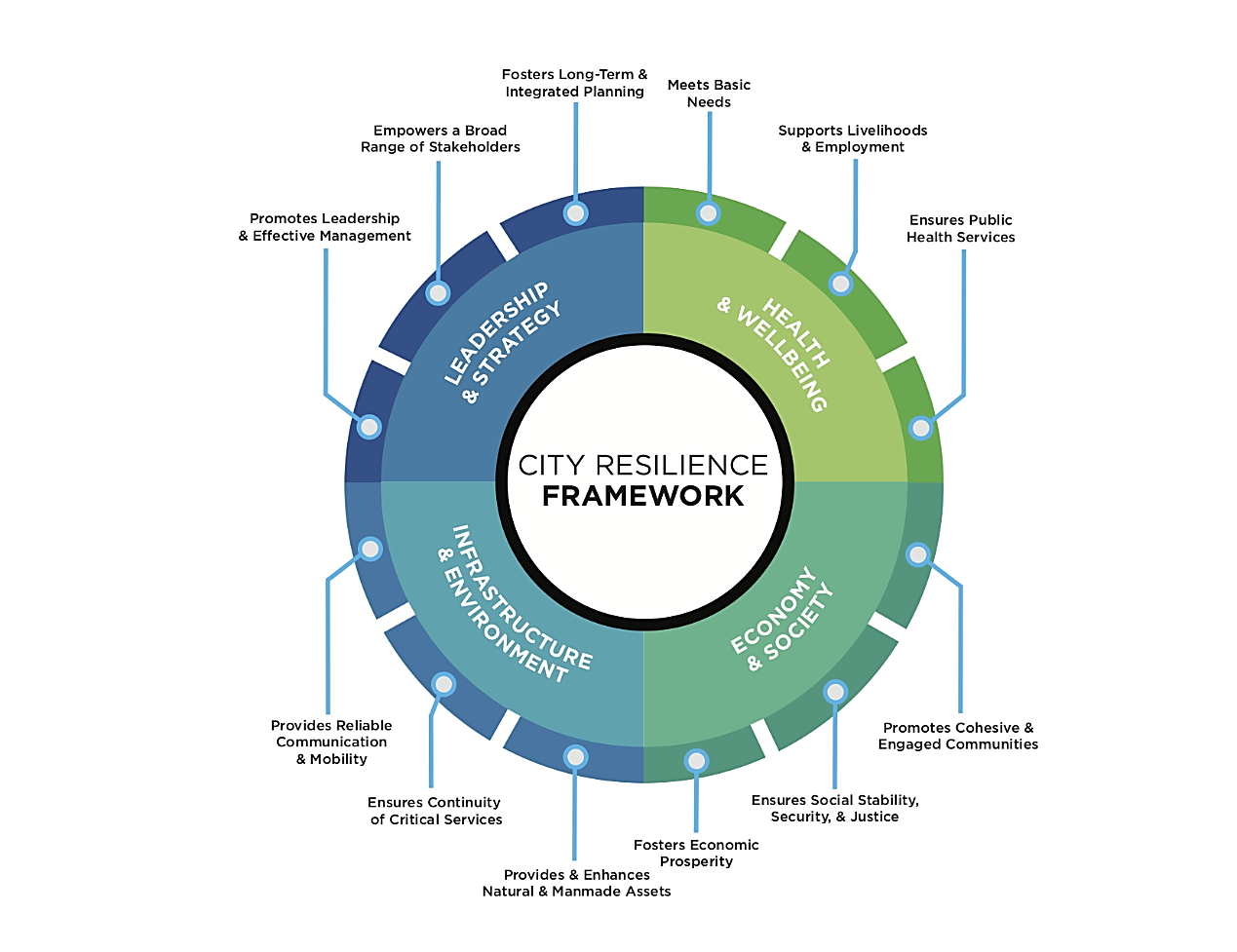
- Cultural Filtering: India must nurture its urbanization in indigenous ways, dealing with challenges by devising solutions that integrate a broader range of local factors. We must tap into lessons from ancient cities of India.
- Urban policy priorities and choices depend on a variety of factors - including the scale, speed and source of urbanisation, the size of cities and the stage of urban development.
- Technology enabled transition: Technology is fundamentally changing the way we live, as we embrace new digital platforms through which citizens and businesses can interact with each other and the city immersed in the ‘internet of things’.
- Bottom up approach harnessing smart citizens: The ‘bottom up’ approach aims to build on sharing economy, featuring self-build, co-operatives, micro industries and greater connectivity.
Conclusion: The current model of urbanisation is unsustainable. A crucial policy implication for government and business is not just to make the mega city workable but to address the urbanisation challenge at its source by helping to combat the distressed migration of 200,000 people a day from the countryside to the city.
India’s ongoing national and state-level initiatives, including Atal Mission for Rejuvenation and Urban Transformation (AMRUT), Housing for All, Smart Cities, Swachh Bharat and Rurban Missions, offer an opportunity to better manage India’s urban transition. The governments at the national, state, and local levels must make greater efforts to ensure that the benefits of urbanisation reach all sections of society.
Question: Discuss the challenges arising due to rapid urbanization. What can be done to ameliorate these issues?
Sources:
- View: India’s urbanisation challenges and the way forward
- Why the world should be watching India's fast-growing cities
- Rapid urbanisation: opportunities and challenges to improve the well-being of societies
- Rapid urbanisation: Where do urban poor stand?
- Rapid urbanisation
- The risks of rapid urbanization in developing countries
- Managing India’s urban transition in 2021
This Day in History - Jamia Milia Islamia University
On 29 October 1920, Jamia Milia Islamia university was established. The inaugural meeting of Jamia was held in the Jama Masjid of Aligarh Muslim University (AMU). At the time of founding Jamia, its founders, such as Zakir Hussain, were associated with AMU. Jamia was later shifted to Delhi. Jamia Millia Islamia, an institution originally established at Aligarh in United Provinces, India in 1920 became a Central University by an act of the Indian Parliament in 1988. In Urdu language, Jamia means ‘University’, and Millia means ‘National’. Other colleges established during the Non-cooperation movement were national institutions like Gujarat Vidyapith, Bihar Vidyapith, Tilak Maharashtra Vidyapith, Kasi Vidyapith and the Bengal National University.
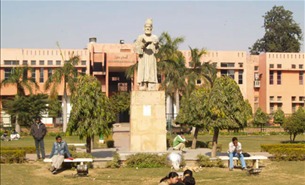
Sources:
Image of the Day - New Robotic Arm at ISS
This is image of the robotic arm to arrive on the International Space Station (ISS), called Gitai S1, a semi-autonomous robot that can operate inside or outside a spacecraft. Gitai S1 has been developed by Tokyo space startup Gitai Japan. A robotic arm is a type of mechanical arm, usually programmable, with similar functions to a human arm; the arm may be the sum. The arm uses a combination of autonomous and guided operation by a ground crew to flip switches, push buttons, and even assemble technological gear, such as solar panels. The plan is for the robotic arm to handle missions that might be dangerous for astronauts.
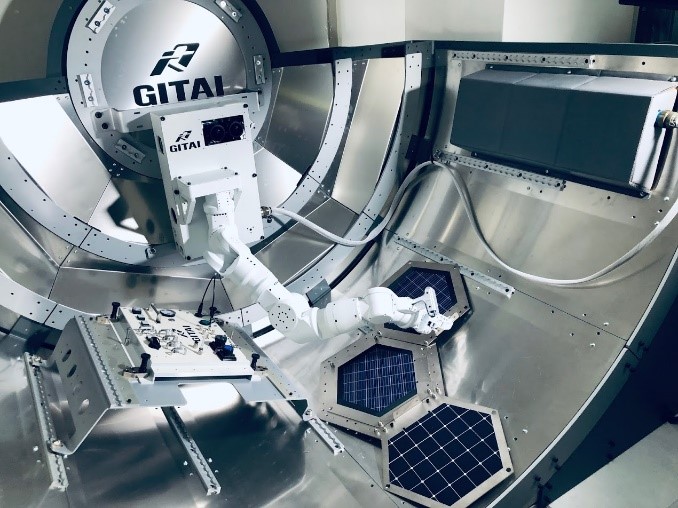
Source:
“Common Prosperity” Drive-China
- Context: The Chinese President has pledged to make progress towards “common prosperity” by 2035 and to achieve the goal by 2050.
- The concept of “common prosperity” has deep roots in the Chinese Communist Party. It was first mentioned in the 1950s by Mao Zedong and in the 1980s by Deng Xiaoping, who modernized the Chinese economy that was devastated by the Cultural Revolution.
- Common prosperity is not egalitarianism. It is by no means robbing the rich to help the poor but to smooth out wealth distribution across Chinese society.
- It means doing a proper job of expanding the pie and dividing the pie- i.e. to not kill the rich to help the poor. It is an essential requirement of socialism.
- It encompasses policies such as curbing tax evasion, imposing inheritance and property tax, limiting the hours that tech sector employees can work, bans on for-profit tutoring in core school subjects etc.

Source:
Carrier Strike Group
- Context: The UK's Carrier Strike Group (CSG) led by its largest warship HMS Queen Elizabeth had sailed into the Bay of Bengal recently.
- A carrier battle group or carrier strike group is a mega naval fleet comprising an aircraft carrier, accompanied by a large number of destroyers, frigates and other ships.
- The strike group can move, act and fight as an integrated and cohesive force, even when spread out across thousands of miles.
- The individual ships can detach from the main group to conduct independent or concurrent tasks as required.
- The UK Carrier Strike Group, which had conducted bilateral Passage Exercise with the Indian Navy comprised of nine ships, 32 aircraft, including F-35B fighters and choppers, and 3,700 personnel.

Source:
AY.4.2
- Context: The Union health minister has stated that experts are investigating the new variant of Sars-Cov-2 virus- AY.4.2 in India.
- The AY.4.2 is an evolution/sub-lineage of the Delta variant. It is being currently dubbed as the 'Delta Plus'
- In the past months, the Delta Plus variant was said to be a different mutation, B.1.617.2.1/(AY.1), first identified in states across India that was classified as a variant of concern (VoC) by the WHO.
- 4.2 largely has the same mutations as Delta, but with three additional ones - A222V and Y145H in the Spike protein of the virus, and A2529V in a portion known as the ORF1ab.
- As many as 63% of the new cases in the past month have been genomically sequenced to have the AY.4.2 variant that has been traced in parts of Europe, including Denmark and Germany.
- It is believed to be more infectious with a rapid rate of spreading.
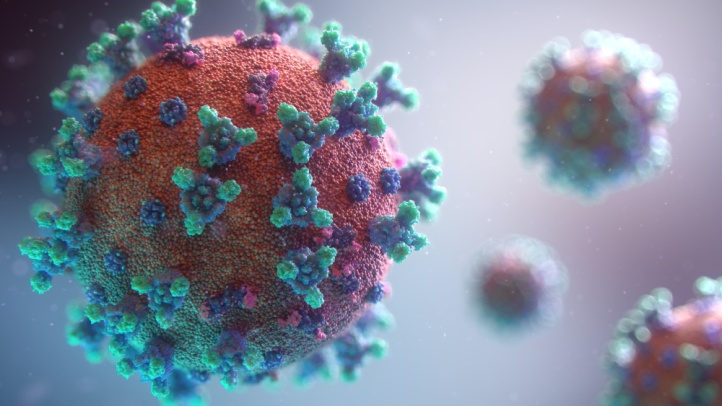
Source:
Wetland Mitras
- Context: The government has declared to form'Wetland Mitras' for taking care of the identified wetlands across the country.
- Mitras are a group of self motivated individuals who have indigenous and local knowledge of the wetland and who are passionate about protecting them.
- They are Influencers who act as a bridge with communities, local self government departments (like panchayats, municipalities and corporations).
- They play an important role in:
- Increasing the conservation efforts.
- Enhancing the micro level participation through increased sphere of influence.
- Strengthening governance and sustainability.
- Providing feedback mechanism on management effectiveness.
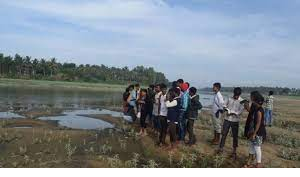
Source:
What India’s new water policy seeks to deliver: IE
Essence: The new National Water Policy (NWP), drafted by independent experts, recognized the need for demand management and called for crop diversification as 80-90 percent of water is used by irrigation and that too for few crops. Reduce-Recycle-Reuse was proposed as the basic mantra of integrated urban water supply and wastewater management. On the supply side, it called various systems such as pressurized micro-irrigation for expansion of irrigation. Emphasis was placed on nature-based solutions and specially curated blue-green infrastructure for urban areas.
The NWP gave the highest priority to sustainable, participatory and equitable management of groundwater. It outlined a process to draft a Rights of Rivers Act and considered water quality was an un-addressed issue. It suggested the creation of a unified multi-disciplinary, multi-stakeholder National Water Commission (NWC) for reforming governance of water as many departments work in silos.
Why you should read this article?
- To understand the issues associates with water crisis in India.
- To know about the new National Water Policy.
Source:
Getting the focus back on early childhood education: TH
Essence: The article talks about Early Childhood Education (ECE). ECE is crucial to the overall development of children, as it impacts their learning and earning capabilities throughout their lifetimes. Despite this, little attention has been given to continuance of ECE delivery during the COVID-19 school closures. The article has also stressed on several challenges associated with ECE like: priority to older child’s education over ECE; low attendance in the anganwadi system, etc.
Hence, to overcome these issues we need to take steps like- more parental engagement in ECE by understanding the barriers, bridging the digital divide in the country, more decentralised approach of identifying and alleviating the barriers, provision of non-educational support to low-income households to alleviate income and food insecurities, information about teacher’s experiences and on innovations they have developed to increase parental engagement during school closures. It is crucial to cross these barriers as we are moving towards achieving universal and equitable ECE, as envisioned in the National Education Policy (NEP) 2020. Also, while teachers remain at the centre of this effort, we must also make sure they are not further overburdened, by providing adequate resources and institutional support.
Source:
Trade Unions Adapting to protect the interests of Gig workers: BL
Essence: Gig workers whose numbers increased exponentially in India in the pandemic lack a collective voice to air their demands and negotiate solutions with platforms they work with. Experience of United States and UK shows that conventional trade unions are beginning to take up issues of gig workers and getting legislations passed to protect their interests. Article points out that lack of alternate opportunities and consequent low bargaining power of Indian gig workers are making evolution of gig organization difficult in India.
However, recent uses of social media to build pressure on platforms gives a sign of imminent rise of a collective voice which will ensure the sector grows sustainably, benefiting everyone.
Why should you read this?
- To understand the importance of a collective organization to protect the interest of voiceless and unorganized gig workers.
- To understand how trade Unions are evolving with changed realities to air demands of gig workers.
- To understand why gig workers organization in India yet to take roots while its already making differences in developed world.
Source:
A Sustainable School
Background
- Eco-friendly sustainable measures are often considered as difficult to achieve or expensive, without considering the long-term benefits.
- But C M Nagaraja, a school teacher from Bengaluru proved this perception to be a myth, when he used sustainable practices in the school.
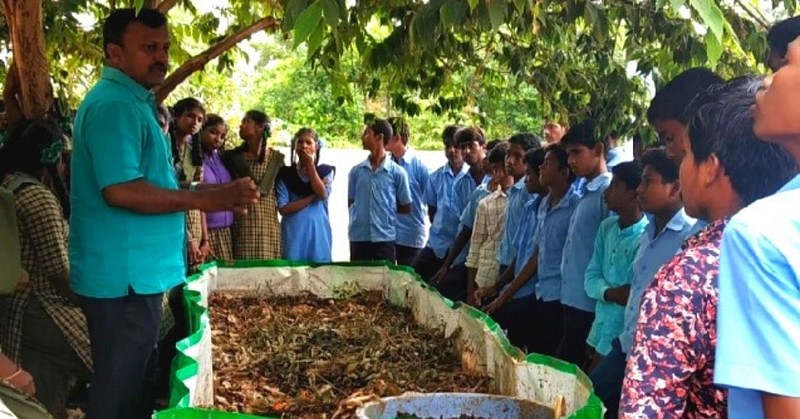
How the school is converted into sustainable one?
- The project started with a waste management programme, by repurposing the old and broken metal-based furniture.
- Milk pouches were upcycled into computer covers. Bio-waste converters and bins were installed for paper and plastic waste.
- Five underground water recharging pits to store rainwater and wastewater have been made for various non-potable uses.
- Discarded bottles were used to make chemistry portable kits, with which the students could conduct chemical experiments at home.
Quote:
Teaching kids to count is fine, but teaching them what counts is best. – Bob Talbert
Source:
Share the article
Get Latest Updates on Offers, Event dates, and free Mentorship sessions.

Get in touch with our Expert Academic Counsellors 👋
FAQs
UPSC Daily Current Affairs focuses on learning current events on a daily basis. An aspirant needs to study regular and updated information about current events, news, and relevant topics that are important for UPSC aspirants. It covers national and international affairs, government policies, socio-economic issues, science and technology advancements, and more.
UPSC Daily Current Affairs provides aspirants with a concise and comprehensive overview of the latest happenings and developments across various fields. It helps aspirants stay updated with current affairs and provides them with valuable insights and analysis, which are essential for answering questions in the UPSC examinations. It enhances their knowledge, analytical skills, and ability to connect current affairs with the UPSC syllabus.
UPSC Daily Current Affairs covers a wide range of topics, including politics, economics, science and technology, environment, social issues, governance, international relations, and more. It offers news summaries, in-depth analyses, editorials, opinion pieces, and relevant study materials. It also provides practice questions and quizzes to help aspirants test their understanding of current affairs.
Edukemy's UPSC Daily Current Affairs can be accessed through:
- UPSC Daily Current Affairs can be accessed through Current Affairs tab at the top of the Main Page of Edukemy.
- Edukemy Mobile app: The Daily Current Affairs can also be access through Edukemy Mobile App.
- Social media: Follow Edukemy’s official social media accounts or pages that provide UPSC Daily Current Affairs updates, including Facebook, Twitter, or Telegram channels.




